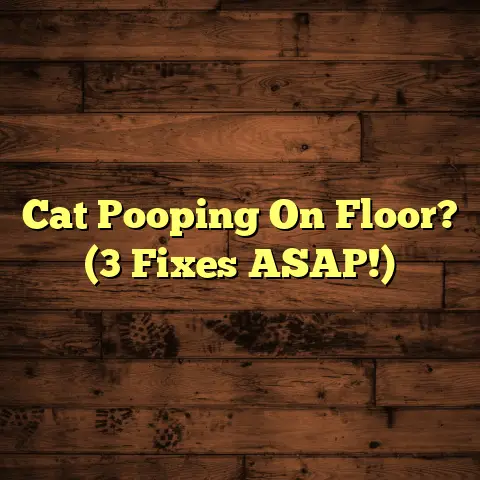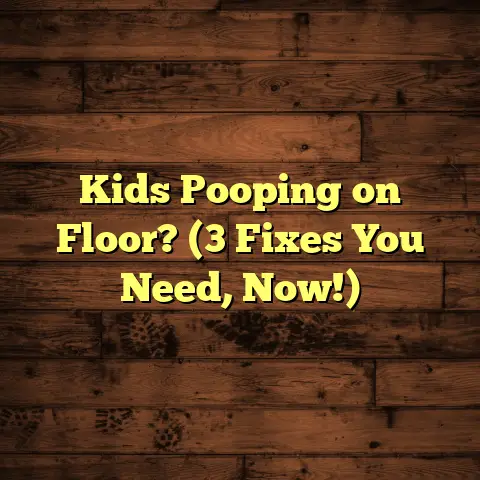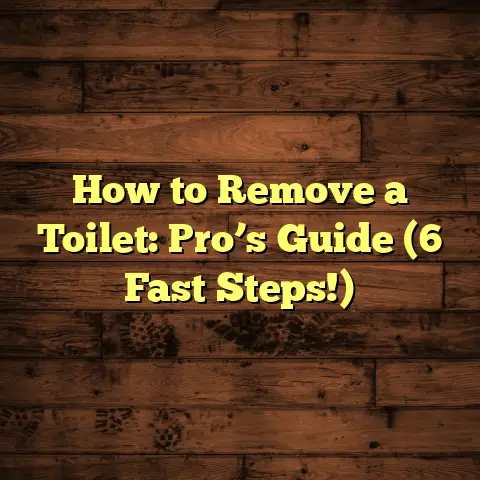Laminate Flooring Problems & Repair? (5 Issues!)
And let me tell you, laminate flooring, while a fantastic option for many, isn’t immune to its fair share of problems. But don’t worry, I’m here to guide you through the most common issues and, more importantly, how to fix them!
Discussing Investment in Laminate Flooring
Let’s talk laminate. It’s the chameleon of the flooring world, mimicking the look of hardwood, tile, and even stone, without breaking the bank.
It’s a popular choice, and for good reason. The initial investment is significantly lower than, say, solid hardwood. I’ve seen homeowners save anywhere from 30% to 50% by choosing laminate over hardwood. That’s a huge chunk of change!
Think of it this way: you can get a beautiful wood-look floor for around $2 to $5 per square foot installed, compared to $8 to $15+ for hardwood. That difference adds up, especially in larger homes.
Now, laminate isn’t a lifetime floor like some hardwoods can be. But with proper care, you can easily get 10-20 years out of it. And that cost-effectiveness over time? It’s a no-brainer for many.
Plus, it’s a great option for rentals. Landlords love it because it’s durable and easy to clean, reducing the hassle and cost of frequent replacements.
Alright, enough about the good stuff. Let’s get real about the potential pitfalls.
Addressing the Top 5 Common
Laminate Flooring Problems
Here are the top 5 issues I encounter most often, along with my tried-and-true repair strategies.
1. Issue 1: Warping and Buckling
Ugh, warping and buckling. The bane of any flooring contractor’s existence! What causes it?
Usually, it’s moisture. Water is laminate’s enemy. Whether it’s a leaky pipe, a spill that wasn’t cleaned up quickly, or even excessive humidity, moisture can seep into the seams and cause the core of the laminate to swell.
Improper installation is another culprit. If the flooring wasn’t acclimated properly before installation (meaning it wasn’t allowed to adjust to the room’s temperature and humidity), it can expand and contract excessively, leading to buckling.
Temperature fluctuations can also play a role, especially in areas with extreme seasonal changes.
What does it look like?
Visually, warping looks like raised areas in the floor, often near the seams between planks. Buckling is more dramatic – the planks actually lift off the subfloor, creating a noticeable bump.
Both can be unsightly and even create tripping hazards.
How do you fix it?
Okay, here’s the breakdown:
-
Identify the Source of Moisture: This is crucial! You can’t fix the problem until you stop the water from coming in. Check for leaky pipes, overflowing toilets, or even condensation issues. Use a moisture meter to pinpoint the areas with the highest moisture content.
-
Fix the Underlying Issue: Repair the leak, improve ventilation, or install a dehumidifier. Addressing the root cause is paramount.
-
Repair or Replace Damaged Planks: This depends on the severity of the damage.
-
Minor Warping: Sometimes, removing the baseboards and allowing the flooring to “breathe” can help it settle back down. You might also try placing heavy objects on the warped area for a few days.
-
Severe Warping or Buckling: Unfortunately, replacement is usually necessary. Carefully remove the damaged planks, making sure not to damage the surrounding ones. Clean the subfloor and install new planks, ensuring they are properly acclimated and installed according to the manufacturer’s instructions.
-
Pro Tip: When replacing planks, try to use planks from the same batch as your original flooring to ensure a consistent color and pattern. If that’s not possible, you might need to replace a larger section to avoid a noticeable difference.
2. Issue 2: Scratches and Dents
Laminate is tough, but it’s not invincible. Scratches and dents are almost inevitable, especially in high-traffic areas or homes with pets and kids.
What causes them?
Think about it:
-
Furniture: Dragging furniture across the floor is a surefire way to create scratches. Even small movements can leave marks over time.
-
Pets: Claws can scratch the surface, especially if your furry friend gets the zoomies.
-
Heavy Foot Traffic: Dirt and grit tracked in on shoes can act like sandpaper, gradually wearing down the finish.
-
Dropped Objects: A dropped can of soup or a heavy vase? Dent city.
How do you fix them?
Luckily, minor scratches and dents are usually easy to fix.
-
Laminate Floor Repair Kits: These kits are your best friend. They typically include a putty or wax filler that you can use to fill in the scratch or dent. Follow the instructions carefully, matching the color of the filler to your flooring as closely as possible.
-
Filling in Scratches: For very minor scratches, you can sometimes use a furniture touch-up marker that matches the color of your flooring.
-
Preventative Measures: This is key!
-
Use Furniture Pads: Place felt pads under all furniture legs to prevent scratches.
-
Use Rugs: Area rugs in high-traffic areas can protect your flooring from wear and tear.
-
Clean Regularly: Sweep or vacuum frequently to remove dirt and grit.
-
Trim Pet’s Nails: Keep those claws trimmed!
-
Pro Tip: When using a repair kit, apply the filler in thin layers, allowing each layer to dry completely before applying the next. This will prevent the filler from shrinking and cracking.
3. Issue 3: Fading and Discoloration
Sunlight is a powerful force, and it can wreak havoc on your laminate flooring over time.
What causes it?
Excessive sunlight exposure is the main culprit. The UV rays in sunlight can break down the pigments in the laminate, causing it to fade or change color.
Uneven fading is common, especially in areas where furniture or rugs block the sunlight. You might end up with lighter areas where the furniture was and darker areas around it.
How do you fix it?
Unfortunately, once fading has occurred, it’s difficult to reverse. Prevention is the best medicine here.
-
Window Treatments: Use curtains, blinds, or shades to block out direct sunlight during peak hours.
-
Reposition Furniture: If possible, rearrange your furniture periodically to allow for more even exposure to sunlight.
-
Replace Severely Faded Planks: If the fading is severe, you might need to replace the affected planks. As with warping and buckling, try to match the replacement planks as closely as possible to the original flooring.
Pro Tip: Consider using UV-resistant window film to block out harmful UV rays without completely blocking the sunlight.
4. Issue 4: Loose or Clicking Planks
That annoying clicking sound when you walk across your floor? That’s likely caused by loose planks.
What causes it?
-
Improper Installation: This is a common cause. If the planks weren’t properly locked together during installation, they can loosen over time.
-
Humidity Changes: Fluctuations in humidity can cause the planks to expand and contract, which can weaken the locking mechanisms.
-
Natural Settling: Over time, the subfloor can settle, creating slight unevenness that can cause the planks to loosen.
Why is it a problem?
Loose planks aren’t just annoying; they can also be a tripping hazard. Plus, the constant movement can further damage the locking mechanisms, leading to even more problems.
How do you fix it?
-
Re-securing Planks: Sometimes, you can simply re-secure the loose planks by gently tapping them back into place with a rubber mallet. Use a tapping block to protect the edges of the planks.
-
Checking the Underlayment: If the planks are still loose after re-securing them, check the underlayment. Make sure it’s level and in good condition. If it’s damaged, you might need to replace it.
-
Maintaining Expansion Gaps: Laminate flooring needs room to expand and contract. Make sure there’s a proper expansion gap (usually around 1/4 inch) around the perimeter of the room. If the gap is too small, the flooring can buckle and loosen.
Pro Tip: If you’re having trouble re-securing a plank, try using a small amount of wood glue to hold it in place. Be careful not to use too much glue, as it can make it difficult to remove the plank later if needed.
5. Issue 5: Gaps Between Planks
Gaps between planks are not only unsightly, but they can also trap dirt and moisture, leading to more serious problems down the road.
What causes them?
-
Settling: As the house settles, the subfloor can shift, creating gaps between the planks.
-
Humidity Changes: As with loose planks, fluctuations in humidity can cause the planks to expand and contract, leading to gaps.
-
Inadequate Installation: If the planks weren’t installed tightly together, gaps can form over time.
Why is it a problem?
Gaps can trap dirt and debris, making it difficult to keep your floor clean. They can also allow moisture to seep into the subfloor, potentially leading to mold and mildew growth.
How do you fix it?
-
Using Wood Filler: For small gaps, you can use wood filler to fill them in. Choose a filler that matches the color of your flooring as closely as possible. Apply the filler with a putty knife, smoothing it out and wiping away any excess.
-
Re-spacing Planks: In some cases, you might be able to re-space the planks to close the gaps. This involves carefully removing the baseboards and using a pry bar to gently shift the planks into place.
-
Replacing Affected Sections: If the gaps are large or widespread, you might need to replace the affected sections of the flooring.
Pro Tip: When using wood filler, overfill the gap slightly, as the filler will shrink as it dries. Once the filler is dry, sand it smooth with fine-grit sandpaper.
Conclusion: Summary of Repair Strategies
So, there you have it – my guide to navigating the top 5 common laminate flooring problems. Remember, addressing these issues promptly can prolong the life of your flooring and maintain its aesthetic appeal.
Investing in laminate flooring is a smart move, but it’s important to be prepared for potential problems. With a little knowledge and the right tools, you can keep your laminate floor looking its best for years to come.
And if you ever feel overwhelmed, don’t hesitate to call a professional! I’m always happy to help.





